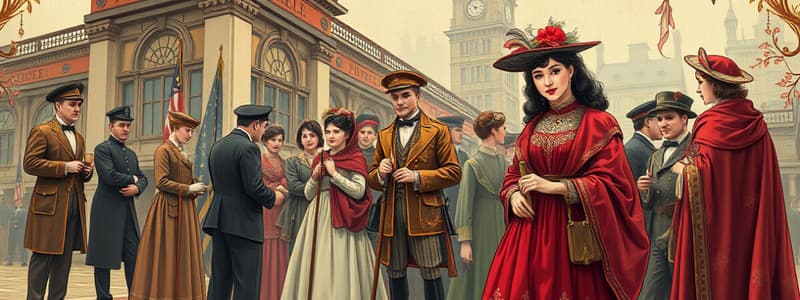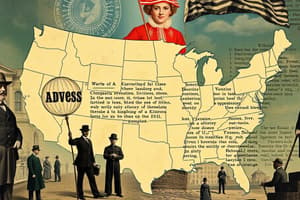Podcast
Questions and Answers
What are the implications of contingency theory in leadership?
What are the implications of contingency theory in leadership?
You can use a broad spectrum of people as leaders.
Which of the following are dimensions that can affect leadership situations? (Select all that apply)
Which of the following are dimensions that can affect leadership situations? (Select all that apply)
- Leader characteristics
- Follower characteristics
- Organizational characteristics
- All of the above (correct)
What did Douglas McGregor identify as major variables involved in leadership?
What did Douglas McGregor identify as major variables involved in leadership?
Characteristics of leader, characteristics of followers, characteristics of organization, characteristics of social, economic, and political environment.
What does the life cycle theory of leadership emphasize according to Hersey and Blanchard?
What does the life cycle theory of leadership emphasize according to Hersey and Blanchard?
What are the key styles of the life cycle theory of leadership? (Select all that apply)
What are the key styles of the life cycle theory of leadership? (Select all that apply)
What does Path-Goal Theory emphasize?
What does Path-Goal Theory emphasize?
What are the key components of Leader-Member Exchange Theory (LMX)?
What are the key components of Leader-Member Exchange Theory (LMX)?
What is a transactional leader?
What is a transactional leader?
What is a transformational leader?
What is a transformational leader?
What is behavioral control in leadership?
What is behavioral control in leadership?
What is output control?
What is output control?
What is input control in leadership?
What is input control in leadership?
What were some of the basic principles the Progressives believed in with respect to the U.S. public personnel system?
What were some of the basic principles the Progressives believed in with respect to the U.S. public personnel system?
What is meant by a position classification system?
What is meant by a position classification system?
What are some of the problems that have historically accompanied the use of merit examinations for hiring public employees?
What are some of the problems that have historically accompanied the use of merit examinations for hiring public employees?
How would a public sector manager handle the performance appraisal process?
How would a public sector manager handle the performance appraisal process?
What is meant by the concept of 'representative bureaucracy'?
What is meant by the concept of 'representative bureaucracy'?
What were the basic provisions of the Civil Service Reform Act of 1978?
What were the basic provisions of the Civil Service Reform Act of 1978?
What are some challenges when creating a performance appraisal system?
What are some challenges when creating a performance appraisal system?
What are some of the constant problem areas in the budgeting process?
What are some of the constant problem areas in the budgeting process?
What are the basic stages of the federal budget cycle?
What are the basic stages of the federal budget cycle?
What are some important considerations when deciding on the type and amount of tax?
What are some important considerations when deciding on the type and amount of tax?
Explain the differences between program budgeting, performance budgeting, and line-item budgeting.
Explain the differences between program budgeting, performance budgeting, and line-item budgeting.
What are the benefits and disadvantages of using property tax to generate income?
What are the benefits and disadvantages of using property tax to generate income?
Why balancing the budget may not be a laudable objective from a countercyclical fiscal policy perspective?
Why balancing the budget may not be a laudable objective from a countercyclical fiscal policy perspective?
What is PPBS and why was it difficult to implement in the federal government?
What is PPBS and why was it difficult to implement in the federal government?
Compare and contrast incremental versus rational models of budgeting.
Compare and contrast incremental versus rational models of budgeting.
What are the basic advantages and disadvantages of federalism as practiced in the U.S.?
What are the basic advantages and disadvantages of federalism as practiced in the U.S.?
What is meant by fiscal federalism?
What is meant by fiscal federalism?
Explain the differences between mayor-council, council-manager, and commission plan for structuring local government.
Explain the differences between mayor-council, council-manager, and commission plan for structuring local government.
What are the universal traits identified in Trait Theory of leadership?
What are the universal traits identified in Trait Theory of leadership?
What does Behavioral Theory focus on regarding leadership?
What does Behavioral Theory focus on regarding leadership?
What is the focus of Contingency Theory in leadership?
What is the focus of Contingency Theory in leadership?
What does Fred Fiedler's Contingency Theory assess?
What does Fred Fiedler's Contingency Theory assess?
Flashcards are hidden until you start studying
Study Notes
Progressives and the U.S. Public Personnel System
- Advocated for competitive examinations to select employees.
- Emphasized depoliticizing hiring based on professional competence rather than political affiliations.
- Established the Civil Service Commission to safeguard against political patronage.
- Introduced the Lloyd-LaFollette Act (1912) to protect tenure in office, extending merit principles to dismissals.
Position Classification Systems
- Organizes jobs based on duties, creating formal job descriptions for authority clarity.
- Aims to define roles as interchangeable, enhancing clarity for employees.
- May lead to outdated job descriptions and confusion when technical specialists move to administrative roles.
- Works best for standardized jobs; struggles to accurately reflect complex professional roles.
Merit Examinations and Hiring Issues
- Concerns about validity; do tests adequately match job requirements?
- Accusations of discrimination, particularly against minorities with biased exams.
- Cultural bias results in systematic disadvantages for specific cultural groups.
Performance Appraisal Process Challenges
- Essential for employee development, correcting poor performance, and capturing work history.
- Possible biases where appraisals reflect the rater's perceptions rather than the employee's performance.
- Difficulties in measuring output and potential conflicts in appraisal functions can hinder accuracy.
Representative Bureaucracy
- Reflects demographic diversity of society in public workforce to enhance responsiveness.
- Advocates argue it improves government consideration of diverse concerns.
- Critics highlight that diversity-focused hiring may fall short of merit-based principles.
Civil Service Reform Act of 1978
- Acknowledged high-level positions with policy-making duties.
- Created Office of Personnel Management and Merit Systems Protection Board.
- Added Federal Labor Relations Authority and Senior Executive Service, enhancing management flexibility.
Budgeting Process Challenges
- Length of budget cycle can lead to inefficiencies and excessive revisions.
- Potential rigidity of budgets may hinder quick responsiveness to crises.
- Use of budgetary slack introduces ethical concerns in revenue estimations and expenditures.
Federal Budget Cycle Overview
- Involves stages from agency budget formulation to Congressional submission.
- Includes preparation by the Office of Management and Budget (OMB) and legislative review.
- Ends with budget execution and auditing of agency expenditures.
Tax Considerations in Policy Making
- Politically acceptable, administratively feasible, and efficient taxes are essential.
- Price elasticity impacts demand sensitivity, affecting tax effectiveness.
- Comprehensive understanding of implementation costs is crucial.
Budgeting Models
- Program Budgeting: Details costs of activities within a budget.
- Line-item Budgeting: Lists specific items and their expenses.
- Performance Budgeting: Links output data to costs and efficiency metrics.
Income Generation Through Taxes
- Property Tax: Major local revenue source, challenges include affordability for low-income residents.
- Sales Tax: Regarded as regressive, disproportionately affecting lower-income families.
Fiscal Policy and Budget Balancing
- Countercyclical fiscal policy counters economic cycles through spending adjustments.
- Balancing budgets in downturns may inhibit necessary agency funding requests.
PPBS Implementation Challenges
- Planning-Programming Budgeting System promotes analytical techniques for decisions.
- Difficulties include misunderstanding, lack of commitment, and insufficient skills for complex budgeting.
Incremental vs. Rational Budgeting Models
- Incremental budgeting looks at past expenditures for future budgets, limiting thorough review.
- Rational budgeting employs systematic steps for comprehensive decision-making but can overlook potential alternatives.
Federalism in the U.S.
- Advantages: Adapts government programs to local needs, decentralizes power.
- Disadvantages: Local priorities may overshadow broader regional or national goals, risking fragmentation and accountability.
Fiscal Federalism and Grant Programs
- Fiscal federalism involves intergovernmental fund transfers.
- Types of grants: Categorical grants for specific goals, Project grants requiring applications, Formula grants based on federal criteria, Block grants offering broad discretion in spending.
Local Government Structures
- Mayor-Council: Voters elect mayor and council; power varies by model (weak vs. strong).
- Council-Manager: Elected council appoints an administrative city manager.
- Commission Plan: Elected body exercises legislative power collectively, with leadership roles rotating.
Leadership Theories
- Trait Theory: Focuses on inherent traits for leadership, recognizing variability depending on context.
- Behavioral Theory: Studies leader actions and their impact on productivity and job satisfaction.
- Contingency Theory: Adapts leadership style to situational demands, recognizing that effectiveness varies by context.
Leadership Styles and Approaches
- Transactional Leadership: Uses rewards to motivate performance, often prevalent in government.
- Transformational Leadership: Inspires employees towards a higher purpose, fostering personal and organizational growth.
- Leader-Member Exchange Theory: Emphasizes dyadic relationships between leaders and followers for effectiveness.
Supervision and Control Styles
- Behavioral Control: Focused on monitoring procedures and methods used by employees to complete tasks, emphasizing managerial knowledge of tasks.
Studying That Suits You
Use AI to generate personalized quizzes and flashcards to suit your learning preferences.




